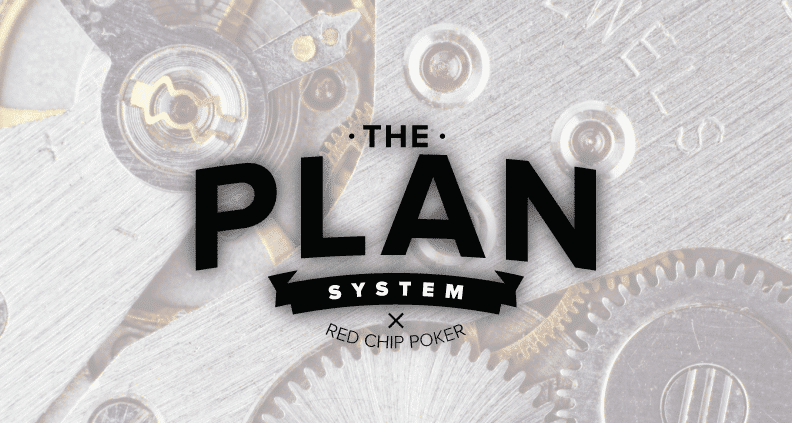In the beginning, everything is new and full of possibilities. Preflop in poker is no different. You can limp, fold, raise to a number of different sizes…and all for a number of different reasons. But knowing which action to take preflop can be a bit complex when you first start out. So this guide is going to walk you through the PLAN system: a simple system for helping you choose better decisions when you are utterly lost and confused.

POSITION
As always, position is a key factor in any poker decision you make. Before you open-raise or limp behind, consider what your position is likely to be if the hand goes postflop. Being in-position makes postflop significantly easier – giving you more options when it comes to bluffing, floating, and value betting. This doesn’t meant that you want to avoid +EV situations simply because you will be out-of-position (OOP) going postflop…but look to play more hands when you will have position postflop.
- Play far fewer hands from early position than late position.
- Who are the players between yourself and the button? If you raise JTo and they are all likely to call you, is your JT going to play well OOP in a very multi-way pot?
- Limping behind from MP1 may seem like a good idea, but will that aggressive player on the button raise and put you in a bad spot where you’ll be OOP postflop?
LOCATION (OF WEAK PLAYERS)
Before you do anything, consider where the weaker players are. Games run around weak players, and the table dynamics can change dramatically based upon how many weak players are there and exactly where they are sitting in a given hand. Before raising a hand preflop, figure out where the weak players are sitting and what’s likely to happen if you raise and they call. Weak players are notorious for calling a ton of preflop raises with trashy hands…so plan ahead before you raise with hands like 22, 76s, and Q9o.

In the situation above, what would you do? Well the weak players are between you and the button which means if any/all of them call your raise, you are going to be OOP going postflop. This makes bluffing tougher (before you factor in the fact that weak players dislike folding very often anyway!) and really forces you to smash a big hand on the flop. Also consider that if one or more weak players call your raise, it gives great pot odds to any NIT or TAG with speculative hands which can create very multi-way pots.

In this spot the weak players are in the blinds…meaning if they do continue we are going to have position. Now we can raise many more hands since we’ll have control postflop. Before you make your action preflop, find the weak players first and estimate how their reactions to your action will impact your bottom line.
Want to play more hands preflop? Start by listening to this podcast about playing a more LAG style.
AGGRESSION
When in doubt, aggressive play is better than passive play. This means you should typically look to raise a hand rather than limp a hand. This isn’t to say that limping is incorrect in certain spots (heck, we have a complete article about the benefits of limping preflop)…but it’s easy to get caught up in limping far too many hands and missing good spots for aggressive play where you could easily pick up pots preflop or on the flop with a CB.
That being said, aggression works best with a plan. It works best when you are in-position (or WILL BE in-position). Aggressive bluffs work best in HU pots vs 5-way pots. To really utilize aggression, you have to think ahead. Consider what’s likely to happen, if you could win the pot outright with some extra aggression (hint: light 3bets are good for this!), and whether a limp or raise (or call vs re-raise) creates a more valuable situation for your hand.
NO LIMIT
This may seem basic, but so many players forget this. We are playing NO Limit Hold ‘Em! We can make HUGE raises whenever we want, but so few players consider breaking out of the “normal raise-size bubble”. Sure, it’s standard to open-raise to 3bb online or 5bb at $1/$2 live…but it’s NOT the only raise size we have available. It’s OK to use sizes that look a little out of place, if they are made with the right reason and help to create a more +EV opportunity for you and your hand.
Poker is a game that is deeply rooted in logic, but creative plays and ideas are a great way to increase your edge. There was a great forum thread and video on this same topic that you should checkout all about the pain threshold in poker…so if you want to dive down the rabbit hole of bet sizing and dynamics, this is a great place to start.
Of course, there are other considerations when crafting your preflop line…but if you keep the PLAN system in place – position, location of weak players, aggression, and no limit sizing – you will choose the right action far more often! If you have any questions, just leave a comment below and I’d be happy to start a conversation =)


GREAT article!!
Thanks Bill =)
Great Article. Between your great free vids and rcp coach Ed Miller’s books @40% off I think I’m on my way to becoming a far better player.
Thanks Dale, and congrats on your journey towards better poker!
James,
I have been playing for a few years, mainly on one as I live in GA, but I go to the casino 1-2 times a year when I can. I only play $1 $2 cash. My question is what kind of range do these opponents have when they limp, I raise and then they shove. The always confuses me as I have seen a few guys turn over AA and also T3 off.
thanks Doug, good stuff – I appreciate it
Chris, run across this from time to time. The reality/situation can and is usually based on a variety of factors in my experience. There can be several factors at play to consider:
1. Did they limp from UTG or UTG +1? If so, and you are first raise, they may be slow playing a major hand in hopes of a raise, so they can re-raise. If their hand is that strong jamming an entire stack may lose value, but learn about SPR to see if from an SPR perspective that move makes sense. If the SPR isn’t there, then they can still have a premium hand and are afraid of the “Suck Out” so they’re just trying to get everyone out the pot
2. What is your table image? If they have you as a passive player or NIT, then they may very well re-pop you all-in w/a wide range of hands, expecting you to fold.
3. Are they tilting or just a crazy bad player?
4. A lot of times if the person jamming it to your raise after limping is in a heads up position against you, I tend to see a wider range of hands here, especially those lower & middle pairs, since in a HU situation they have a better chance of standing up.
As already stated there are several factors which can lead into this action. As soon as you sit down at the table try to get a read on the types of players there, as this will (believe it or not) help you in your decision when this situation happens again. Best of luck
Chris,
Well, you never know for sure. A big factor in this would be the size of the shove and past history with them along with their perception of you. There are guys where this is just going to be big pocket pairs. There are people that are on complete monkey-tilt and will show up with T3o. Sometimes it is a more rational person where the y limp, there was a raise and a few calls. They decide “there is enough in the pot” and just ship it in where they usually have a medium pocket pair or better.
This is a question with no right answer. However, there are patterns and you can make better decisions based on them. Do you have to be right every time? No, just being right more often then you are wrong is enough!
Awesome tips, thanks!
You’re very welcome!
In my experience very few players at $1/2 cash at the Venetian where I play are going to bluff/shove preflop. My opinion is maybe 5% of the time it’s a bluff. The vast majority of the time the players in this game want to play straight up. If a player has been shoving a lot, as in ‘on-tilt’ – sure, it’s more likely he’s bluffing. But it is not worth it to me to test the typical semi-good player by calling his all-in, simply because I don’t expect to win often enough to make it profitable. James, can you suggest a math solution based on my general observation?
If you are making the assumption that their “get it all-in ranges” are nutted, you can easily solve your shoving AND calling vs shoves range using the spreadsheet here: https://redchippoker.com/free-poker-ev-spreadsheet/ . It would only take you ~15 minutes to figure out the bottom of both those ranges vs nutted players =)